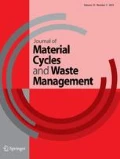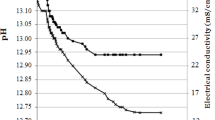Abstract
The phosphoric acid production in the world generates a large amount of phosphogypsum with the emission of toxic acid fluorine gas into the atmosphere, which forms a significant source of environmental contamination. In this work, a novel and a simple procedure allows converting phosphogypsum waste by using hydrofluoric acid and sodium fluoride into valuable products. The obtained results confirm well the efficiency of this procedure, which permits to synthesize at room temperature, the sodium hydrogen sulfate monohydrate and a relatively pure nano-calcium fluoride from the exact stoichiometric proportions of the phosphogypsum, hydrofluoric acid, and sodium fluoride. The total phosphogypsum conversion is achieved after reaction time equal to 1.5 h. Generally, this procedure offers not only a solution for reducing phosphogypsum waste but also permits to obtain valuable products, which interest several sectors of industry.






Similar content being viewed by others
Abbreviations
- AHF:
-
Anhydrous hydrofluoric acid
- cc:
-
Concentered acid
- da:
-
Dilute acid
- FSA:
-
Hexafluosilicic acid H2SiF6
- HF:
-
Hydrofluoric acid
- P:
-
Pump
- PA:
-
Phosphoric acid H3PO4
- PG:
-
Phosphogypsum
- PR:
-
Phosphate rock
- rpm:
-
Rotation per minute
- S:
-
Constant stirring
- SA:
-
Sulfuric acid H2SO4
- STF:
-
Silicon tetrafluoride SiF4
- t:
-
Time reaction (h)
- T:
-
Temperature (°C)
- TC:
-
Temperature control
- WL:
-
Weight loss
- wt:
-
Weight
References
Ennaciri Y (2016) Conversion du phosphogypse en produits valorisable par voie de la chimie douce. Thesis, Chouaib Doukkali University
Samrane K, Al-hjouj M, Doudin F, Kossir A (2011) Fluosilicic acid: recovery system and aluminum fluoride production. Arab Fertil Assoc Publ 11:1–20
European Commission (2007) Reference document on best available techniques for the manufacture of large volume inorganic chemicals-ammonia, acids and fertilisers. Off J Eur Union C 202(2):257–282
Lailach G, Bulan A, Buss G (2001) Process for the preparation of sodium fluoride. Patent No US6251358
Sarawade PB, Kim JK, Hilonga A, Kim HT (2010) Recovery of high surface area mesoporous silica from waste hexafluorosilicic acid (H2SiF6) of fertilizer industry. J Hazard Mater 173:576–580. https://doi.org/10.1016/j.jhazmat.2009.08.125
Gouider M, Feki M, Sayadi S (2009) Separative recovery with lime of phosphate and fluoride from an acidic effluent containing H3PO4, HF and/or H2SiF6. J Hazard Mater 170(2–3):962–968. https://doi.org/10.1016/j.jhazmat.2009.05.067
Matta S, Stephan K, Stephan J, Lteif R, Goutaudier C, Saab J (2017) Phosphoric acid production by attacking phosphate rock with recycled hexafluosilicic acid. Int J Miner Process 161:21–27. https://doi.org/10.1016/j.minpro.2017.02.008
Górecki HJ (1994) Utilization of fluorine from phosphate fertilizer plants. Hodge CA (1994) Pollution control in fertilizer production. CRC Press, Boca Raton, pp 299–335
El Zrelli R, Rabaoui L, Daghbouj N, Abda H, Castet S, Josse C, Beek P, Souhaut M, Michel S, Bejaoui N, Courjault-Radé P (2019) Characterization of phosphate rock and phosphogypsum from Gabes phosphate fertilizer factories (SE Tunisia): high mining potential and implications for environmental protection. Environ Sci Pollut Res 25(15):14690–14702. https://doi.org/10.1007/s11356-018-1648-4
Zieliński M (2006) Utilization of phosphogypsum in the aspect of environmental protection. Przem Chem 85(7):478–482
Gonzalez-Nunez R, Alba MD, Vidal M, Rigol A (2015) Viability of adding gypsum and calcite for remediation of metal-contaminated soil: laboratory and pilot plant scales. Int J Environ Sci Technol 12(8):2697–2710. https://doi.org/10.1007/s13762-014-0671-3
Jarosz-Krzemińska E, Helios-Rybicka E, Gawlicki M (2015) Utilization of neutralized spent sulfuric acid pickle liquor from metal treatment in cement production. Int J Environ Sci Technol 12(9):2901–2908. https://doi.org/10.1007/s13762-014-0694-9
Ennaciri Y, Zdah I, Elaloui Belghiti H, Bettach M (2019) Characterization and purification of waste phosphogypsum to make it suitable for use in the plaster and the cement industry. Chem Eng Commun. https://doi.org/10.1080/00986445.2019.1599865
Karim AA, Kumar M, Mohapatra S, Singh SK, Panda CR (2019) Co-plasma processing of banana peduncle with phosphogypsum waste for production of lesser toxic potassium–sulfur rich biochar. J Mater Cycles Waste Manag 21(1):107–115. https://doi.org/10.1007/s10163-018-0794-6
Ennaciri Y, Mouahid FE, Bendriss A, Bettach M (2013) Conversion of phosphogypsum to potassium sulfate and calcium carbonate in aqueous solution. MATEC Web Conf EDP Sci 5:04006. https://doi.org/10.1051/matecconf/20130504006
Ennaciri Y, Bettach M, Cherrat A, Zegzouti A (2016) Conversion of phosphogypsum to sodium sulfate and calcium carbonate in aqueous solution. J Mater Environ Sci 7(6):1925–1933
Bouargane B, Marrouche A, El Issiouy S, Biyoune MG, Mabrouk A, Atbir A, Bachar A, Bellajrou R, Boukbir L, Bakiz B (2019) Recovery of Ca(OH)2, CaCO3 and Na2SO4 from Moroccan phosphogypsum waste. J Mater Cycles Waste Manag. https://doi.org/10.1007/s10163-019-00910-9
Contreras M, Pérez-López R, Gázquez MJ, Morales-Flórez V, Santos A, Esquivias L, Bolívar JP (2015) Fractionation and fluxes of metals and radionuclides during the recycling process of phosphogypsum wastes applied to mineral CO2 sequestration. Waste Manag 45:412–419. https://doi.org/10.1016/j.wasman.2015.06.046
Burnett WC, Schultz MK, Hull CD (1996) Radionuclide flow during the conversion of phosphogypsum to ammonium sulfate. J Environ Radioactiv 32(1–2):33–51. https://doi.org/10.1016/0265-931X(95)00078-O
Ennaciri Y, Bettach M, Elaloui Belghiti H (2020) Recovery of nano-calcium fluoride and ammonium bisulphate from phosphogypsum waste. Int J Environ Stud 77(2):297–306. https://doi.org/10.1080/00207233.2020.1737426
Kowalski Z, Paszek A (1999) Production of synthetic fluorspar from waste calcium fluoride slurry. Pol J Environ Stud 8:125–128
Rezvani M, Farahinia L (2015) Structure and optical band gap study of transparent oxyfluoride glass-ceramics containing CaF2 nanocrystals. Mater Des 88:252–257. https://doi.org/10.1016/j.matdes.2015.08.159
Fisch AM (2003) Textile techniques in metal: for jewelers, textile artists & sculptors. Lark Books, New York
Toedt J, Koza D, Van Cleef-Toedt K (2005) Chemical composition of everyday products. Greenwood press, Westport
Johnson TM, Murphy B (2008) Use of sodium bisulfate to reduce ammonia emissions from poultry and livestock housing. In: Proceedings of the mitigating air emissions from animal feeding operations, Des Moines, Iowa, pp 74–78
Ennaciri Y, Bettach M (2018) Procedure to convert phosphogypsum waste into valuable products. Mater Manuf Processes 33(16):1727–1733. https://doi.org/10.1080/10426914.2018.1476763
Almeida RM, Pantano CG (1990) Structural investigation of silica gel films by infrared spectroscopy. J Appl Phys 68(8):4225–4232. https://doi.org/10.1063/1.346213
Periasamy A, Muruganand S, Palaniswamy M (2009) Vibrational studies of Na2SO4, K2SO4, NaHSO4 and KHSO4 crystals. Rasayan J Chem 2(4):981–989
Gopalan R (2009) Inorganic chemistry for undergraduates. Universities Press, Hyderabad
Douahem H, Hammi H, Hamzaoui AH, Mnif A (2016) Modeling and optimization of phosphogypsum transformation into calcium fluoride using experimental design methodology. J Tunis Chem Soc 18:106–113
Lamzougui G, Nafai H, Bouhaouss A, Bchitou R (2016) Determination of the maximum content of heavy metals in the phosphogypsum. J Mater Environ Sci 7(6):2161–2169
Macíasa F, Pérez-López R, Cánovas CR, Carrero S, Cruz-Hernandeza P (2017) Environmental assessment and management of Phosphogypsum according to European and United States of America regulations. Procedia Earth Planetary Sci 17:666–669. https://doi.org/10.1016/j.proeps.2016.12.178
Azouazi M, Ouahidi Y, Fakhi S, Andres Y, Abbe JC, Benmansour M (2001) Natural radioactivity in phosphates, phosphogypsum and natural waters in Morocco. J Environ Radioactiv 54(2):231–242. https://doi.org/10.1016/S0265-931X(00)00153-3
Ennaciri Y, Elaloui Belghiti H, Bettach M (2019) Comparative study of K2SO4 production by wet conversion from phosphogypsum and synthetic gypsum. J Mater Res Technol 8(3):2586–2596. https://doi.org/10.1016/j.jmrt.2019.02.013
Bichel J, Schaaf S (2008) U.S. Patent No. 7,393,378. Washington, DC: U.S. Patent and Trademark Office
Vlasjan SV, Voloshin ND, Shestozub AB (2013) Producing calcium nitrate and rare-earth element concentrates by phosphogypsum conversion. Chem Technol 64(2):58–62. https://doi.org/10.5755/j01.ct.64.2.6024
Gutzow I, Zlateva E, Angelov S, Levy S (1989) Structure and properties of thermoluminescent calcium fluoride glass-ceramic materials. J Mater Sci 24:1281–1286
Dahui W, Hao W, Huaijing C, Yujiao Y, Hongyan L (2016) Chemical evolution of LiCoO2 and NaHSO4·H2O mixtures with different mixing ratios during roasting process. Chem Res Chin Univ 32(4):674–677. https://doi.org/10.1007/s40242-016-5490-2
Zhou L (2018) Preparation of calcium fluoride using phosphogypsum by orthogonal experiment. Open Chem 16(1):864–868. https://doi.org/10.1515/chem-2018-0093
Zinke RK, Werkheiser WH (2018) Mineral commodity summaries 2018: U.S. Geological Survey, 200 p, https://doi.org/10.3133/70194932
Meshri DT (1986) The modern inorganic fluorochemical industry. J Fluor Chem 33(1–4):195–226. https://doi.org/10.1016/S0022-1139(00)85278-1
Acknowledgements
The authors would like to thank the responsible of the technological platform of the Faculty of Sciences El Jadida, and the center CAC of Cadi Ayyad University Marrakech for different analyses.
Author information
Authors and Affiliations
Corresponding author
Additional information
Publisher's Note
Springer Nature remains neutral with regard to jurisdictional claims in published maps and institutional affiliations.
Rights and permissions
About this article
Cite this article
Ennaciri, Y., Bettach, M. & El Alaoui-Belghiti, H. Conversion of Moroccan phosphogypsum waste into nano-calcium fluoride and sodium hydrogen sulfate monohydrate. J Mater Cycles Waste Manag 22, 2039–2047 (2020). https://doi.org/10.1007/s10163-020-01088-1
Received:
Accepted:
Published:
Issue Date:
DOI: https://doi.org/10.1007/s10163-020-01088-1




